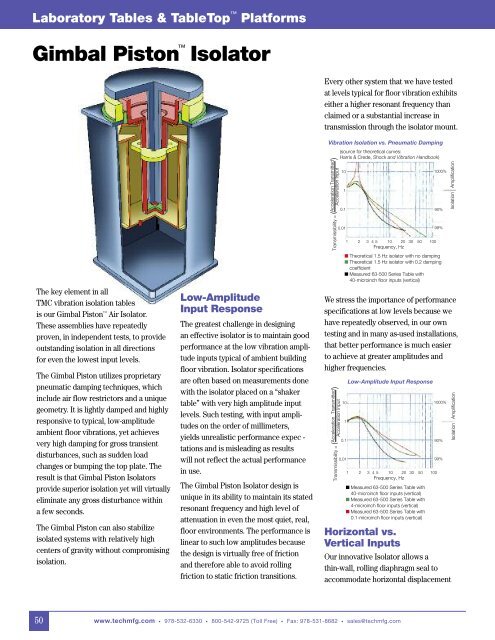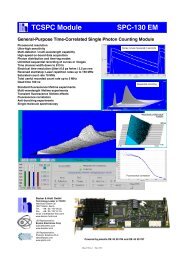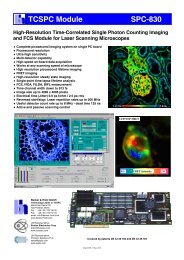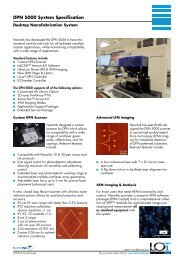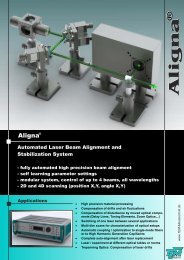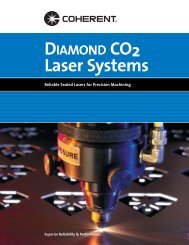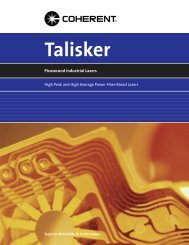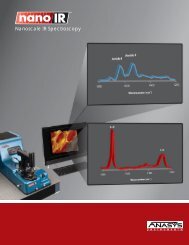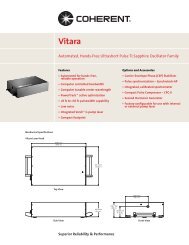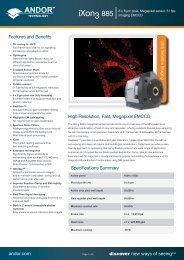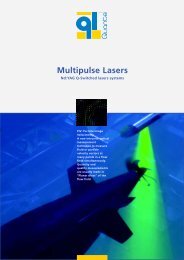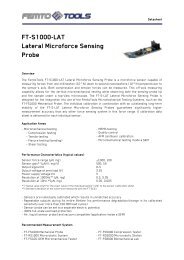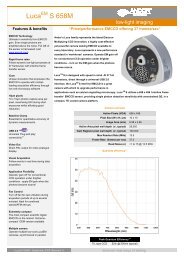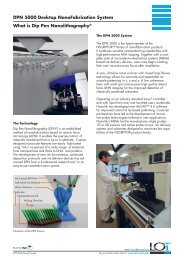Laboratory Tables & TableTop PlatformsGimbal Piston IsolatorThe key element in all<strong>TMC</strong> vibration isolation tablesis our Gimbal Piston Air Isolator.These assemblies have repeatedlyproven, in independent tests, to provideoutstanding isolation in all directionsfor even the lowest input levels.The Gimbal Piston utilizes proprietarypneumatic damping techniques, whichinclude air flow restrictors and a uniquegeometry. It is lightly damped and highlyresponsive to typical, low-amplitudeambient floor vibrations, yet achievesvery high damping for gross transientdisturbances, such as sudden loadchanges or bumping the top plate. Theresult is that Gimbal Piston Isolatorsprovide superior isolation yet will virtuallyeliminate any gross disturbance withina few seconds.The Gimbal Piston can also stabilizeisolated systems with relatively highcenters of gravity without compromisingisolation.Low-AmplitudeInput ResponseThe greatest challenge in designingan effective isolator is to maintain goodperformance at the low vibration amplitudeinputs typical of ambient buildingfloor vibration. Isolator specificationsare often based on measurements donewith the isolator placed on a “shakertable” with very high amplitude inputlevels. Such testing, with input ampli -tudes on the order of millimeters,yields unreal istic performance expec -tations and is misleading as resultswill not reflect the actual performancein use.The Gimbal Piston Isolator design isunique in its ability to maintain its statedresonant frequency and high level ofattenuation in even the most quiet, real,floor environments. The performance islinear to such low amplitudes becausethe design is virtually free of frictionand therefore able to avoid rollingfriction to static friction transitions.Every other system that we have testedat levels typical for floor vibration ex hibitseither a higher resonant frequency thanclaimed or a substantial increase intransmission through the isolator mount.Vibration Isolation vs. Pneumatic Damping(source for theoretical curves:Harris & Crede, Shock and Vibration Handbook)Transmissibility = ( Acceleration Transmitted )Acceleration InputWe stress the importance of performancespecifications at low levels because wehave repeatedly observed, in our owntesting and in many as-used installations,that better performance is much easierto achieve at greater amplitudes andhigher frequencies.Transmissibility = ( Acceleration Transmitted )Acceleration Input1010.10.01Horizontal vs.Vertical Inputs1000%90%99%1 2 3 4 5 10 20 30 50 100Frequency, Hz■ Theoretical 1.5 Hz isolator with no damping■ Theoretical 1.5 Hz isolator with 0.2 dampingcoefficient■ Measured 63-500 Series Table with40-microinch floor inputs (vertical)1010.10.01Low-Amplitude Input Response1 2 3 4 5 10 20 30 50 100Frequency, Hz■ Measured 63-500 Series Table with40-microinch floor inputs (vertical)■ Measured 63-500 Series Table with4-microinch floor inputs (vertical)■ Measured 63-500 Series Table with0.1-microinch floor inputs (vertical)1000%90%99%Our innovative Isolator allows athin-wall, rolling diaphragm seal toaccommodate horizontal displacementIsolation AmplificationIsolation Amplification50 www.techmfg.com • 978-532-6330 • 800-542-9725 (Toll Free) • Fax: 978-531-8682 • sales@techmfg.com
y acting as a gimbal. Instead of usinga cable-type pendulum suspension,the Gimbal Piston Isolator carries theload on a separate top plate that has arigid rod extending down into a wellin the main piston. The bottom of therod has a ball-end that bears on ahard, flat seat.The result is an inherently flexiblecoupling which allows horizontalflexure in the isolator as the ball simplyrocks (without sliding or rolling) veryslightly on the seat.The approach works extremely well,even with sub-microinch levels ofinput displacement, because the staticfriction is virtually the same as therolling friction. Horizontal motion issimply converted to the usual verticaldiaphragm flexure but out of phase:one side of the piston up, the otherdown, in a gimbal-like motion.Transmissibility = ( Acceleration Transmitted )Acceleration Input1010.10.01Horizontal vs. Vertical Isolation1 2 3 4 5 10 20 30 50 100Frequency, Hz■ Measured 63-500 Series Table with40-microinch floor inputs (vertical)■ Measured 63-500 Series Table with4-microinch floor inputs (horizontal)1000%90%99%Isolation Amplificationamplitude vibration isolation perfor -mance is compromised. Though such asystem feels “soft” to gross hand pressure,typical low-level floor vibrationcauses the rubber to act more like arigid coupling than a flexible isolator.Sealed Pneumatic Isolators(Passive)Sealed air isolators do not automaticallyadjust to load changes. The primarylimitation of such systems is that theymust be made too stiff to be effectiveisolators. For example, a passive isolatorwith a true 1.5 Hz resonant frequencywould drift several inches verticallyin response to small changes in load,temperature, or pressure and requireconstant manual adjustment. Thus, nopractical sealed isolators are designedwith such low resonant frequencies.Bearing Slip PlatesIn theory, bearing slip plates shouldallow horizontal isolation by theirdecoupling effect. In practice, for sucha design to work at low amplitudes,it would require precision ground,hardened bearings with impossiblysmall tolerances. The commerciallyavailable versions cannot overcomethe static frictional forces at low amplitudesto get the bearings rolling at all.In addition, all such systems are difficultto align initially and easily drift outof calibration.differentiated primarily by springstiffness: the stiffer the spring, thehigher the resonant frequency. Thus,homemade solutions are limited bytheir high resonant frequency.A Gimbal Piston Isolator with a1.5 Hz vertical resonant frequencybegins to isolate at 2 Hz and canreduce vibration by over 95% at10 Hz. A tennis ball under a steelplate with a 7 Hz resonant frequencybegins to isolate above 10 Hz andreduces vibrations by 90% at 30 Hz.But most building floors exhibit theirhighest vibrational displacementsbetween 5 and 30 Hz, so that a tennisball or rubber pad actually makesthe problem worse by amplifyingambient frequencies between 5 and10 Hz.Transmissibility = ( Acceleration Transmitted )Acceleration Input10Comparative Performance Curves10.10.011000%90%99%1 2 3 4 5 10 20 30 50 100Frequency, Hz■ Measured 63-500 Series Table with40-microinch floor inputs (vertical)■ Measured steel plate on tennis balls (vertical)■ Measured steel plate on rubber pads (vertical)■ Measured steel plate on commercial passiveisolator claiming 5Hz resonanceIsolation Amplification4Limitations of OtherTypes of IsolatorsThick-Wall Rubber DiaphragmsMost commercial isolators employan inexpensive, thick-walled rubberdiaphragm in the piston to achieve verticalisolation. Because of the relativeinflexibility of these elements, lowHomemade AssembliesHome-made isolation systems – often asteel or granite slab placed on rubberpads, tennis balls, or air bladders - willwork only if the disturbing vibrationsare high frequency and minimal isolationis required. While all isolators usethe principle of placing a mass on adamped spring, their performance iswww.techmfg.com • 978-532-6330 • 800-542-9725 (Toll Free) • Fax: 978-531-8682 • sales@techmfg.com51
- Page 3 and 4: Blending Precision Floor Vibration
- Page 5: STACIS ®1Active Piezoelectric Vibr
- Page 8 and 9: (continued)Quiet Island ®Sub-Floor
- Page 10 and 11: (continued)65 Series STACIS ® Floo
- Page 12 and 13: (continued)A Cameca NanoSIMS 50L on
- Page 14 and 15: (continued)STACIS ® supporting the
- Page 16 and 17: Optical iX Tops, Breadboards, & Sup
- Page 18 and 19: iX (continued)Ask about helpful opt
- Page 20 and 21: iX (continued)STACIS iXLaserTable-B
- Page 22 and 23: iX (continued)STACIS iXStage-Base V
- Page 24 and 25: Optical Tops, Breadboards, & Suppor
- Page 26 and 27: Optical Tops, Breadboards, & Suppor
- Page 28 and 29: Optical Tops, Breadboards, & Suppor
- Page 30 and 31: Optical Tops, Breadboards, & Suppor
- Page 32 and 33: Optical Tops, Breadboards, & Suppor
- Page 34 and 35: Optical Tops, Breadboards, & Suppor
- Page 40 and 41: Optical Tops, Breadboards, & Suppor
- Page 42 and 43: Optical Tops, Breadboards, & Suppor
- Page 44 and 45: Optical Optical Tops, Tops, Breadbo
- Page 46 and 47: Optical Tops, Breadboards, && Suppo
- Page 48 and 49: Optical Tops, Breadboards, & Suppor
- Page 50 and 51: Optical Tops, Breadboards, & Suppor
- Page 52 and 53: Laboratory Tables and TableTop Pla
- Page 56 and 57: Laboratory Tables & TableTop Platf
- Page 58 and 59: Laboratory Tables & TableTop Platf
- Page 60 and 61: Laboratory Tables & TableTop Platf
- Page 62 and 63: Laboratory Tables & TableTop Platf
- Page 64 and 65: Laboratory Tables & TableTop Platf
- Page 66 and 67: Laboratory Tables & TableTop Platf
- Page 68 and 69: Laboratory Tables & TableTop Platf
- Page 70 and 71: Laboratory Tables & TableTop Platf
- Page 72 and 73: Pneumatic Advanced Vibration Produc
- Page 74 and 75: Advanced ProductsPneumatic Vibratio
- Page 76 and 77: Electro-Damp ®Electro-Damp ® IIAc
- Page 78 and 79: Electro-Damp ® (continued)NEWPEPS
- Page 80 and 81: Electro-Damp ® (continued)Docking
- Page 82 and 83: Magnetic Field CancellationMag-NetX
- Page 84 and 85: Magnetic Advanced Field Products Ca
- Page 86 and 87: Acoustic Enclosures & Precision Str
- Page 88 and 89: Research Advanced & DevelopmentProd
- Page 91 and 92: The profession of sheet-metal mecha
- Page 93 and 94: Our System 1 and 63-500 Series post
- Page 95 and 96: ≡Technical Background 10Directly
- Page 97 and 98: 1.2.2 Random NoiseRandom, or incohe
- Page 99 and 100: A spring (k) supports the payload a
- Page 101 and 102: 3.0 Practical PneumaticIsolatorsFig
- Page 103 and 104: Figure 7bIn a system with four or m
- Page 105 and 106:
The condition for absolute stabilit
- Page 107 and 108:
4.2 Optical Table ConstructionThere
- Page 109 and 110:
damping of higher-order modes). Tho
- Page 111 and 112:
expressed as a function of frequenc
- Page 113 and 114:
5.4 Types of Active SystemsAlthough
- Page 115 and 116:
Because of the numerous problems as
- Page 117 and 118:
5.5.2 Settling Time Critical Applic
- Page 119 and 120:
5.7.1 Feedforward ProsThere are man
- Page 121 and 122:
5.10 ConclusionsThe challenges crea
- Page 123 and 124:
Blending Precision Floor Vibration


